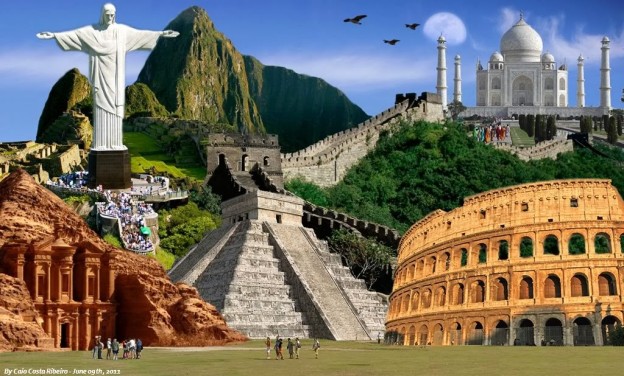With the initiative of Bernard Weber and with a help of a non-profit organization New Open World Corporation started a new project of updating the list of the seven ancient wonders of the world. With the help of survey, via the Internet and telephone over 100 million people gave their votes, and at last according these votes the final list of the New Seven Wonders of the World appeared. The voting results were announced on the 7th of July, 2007 in Lisbon, Portugal.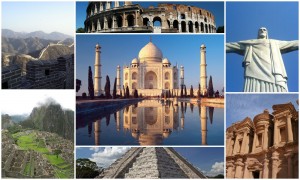 Now we have the list of Modern Seven Wonders of the World and it includes
Now we have the list of Modern Seven Wonders of the World and it includes
Petra Iordaniya
Chichen Itza
Statue of Christ the Redeemer
Coliseum
Great China Wall
Machu Picchu
Taj Mahal
Now let’s make a short review on each of these wonders and get to know more about the history of their creation.
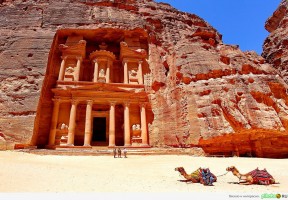 1st place takes Petra. 200 km southward of the Jordanian capital, deep in the mountains of sand in Wadi Musa (“Valley of Moses”) are hidden ruins of ancient Petra. It is believed that the temples and palaces of Petra have been cut in the rock 2000 years before Christ birth by the ancient Arabic nomadic tribe of the Nabataeans. The city was built for 500 years and has become a major trading center. Petra was situated on the crossroads of important trade routes between the Red Sea and the Mediterranean Sea. In Petra there are more than 800 attractions. Temples and tombs, Roman amphitheater with 3000 seats and colonnade, palaces for nobles, baths and canals – everything mentioned was carved from stone.
1st place takes Petra. 200 km southward of the Jordanian capital, deep in the mountains of sand in Wadi Musa (“Valley of Moses”) are hidden ruins of ancient Petra. It is believed that the temples and palaces of Petra have been cut in the rock 2000 years before Christ birth by the ancient Arabic nomadic tribe of the Nabataeans. The city was built for 500 years and has become a major trading center. Petra was situated on the crossroads of important trade routes between the Red Sea and the Mediterranean Sea. In Petra there are more than 800 attractions. Temples and tombs, Roman amphitheater with 3000 seats and colonnade, palaces for nobles, baths and canals – everything mentioned was carved from stone.
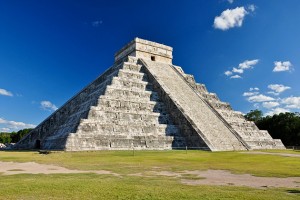 2nd place – Mexican Chichen Itza. Ancient Mayan City – Chichen Itza, is located in the north of Mexico’s Yucatan Peninsula. The name of the ancient city of Chichen Itza means “The well of the Itza tribe.” The city was founded in the VII century BC as the religious center of the Maya tribes, and to the X century it was captured by the Toltecs, who came to the Yucatan from central Mexico and until the XI century it became the capital of the Toltec empire. In 1178 an Indian ruler Hunac Ceel defeated Mayan sanctuary, making a miserable heap of ruins. The city fell into decay and depopulated.
2nd place – Mexican Chichen Itza. Ancient Mayan City – Chichen Itza, is located in the north of Mexico’s Yucatan Peninsula. The name of the ancient city of Chichen Itza means “The well of the Itza tribe.” The city was founded in the VII century BC as the religious center of the Maya tribes, and to the X century it was captured by the Toltecs, who came to the Yucatan from central Mexico and until the XI century it became the capital of the Toltec empire. In 1178 an Indian ruler Hunac Ceel defeated Mayan sanctuary, making a miserable heap of ruins. The city fell into decay and depopulated.
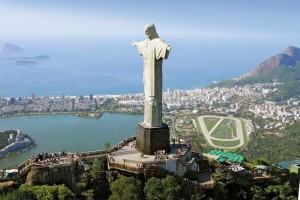 3d place belongs to Statue of Christ the Redeemer in Rio de Janeiro. The giant statue of Christ the Redeemer crowning 710-meter Corcovado mountain, is already for 80 years widely regarded as a symbol of Rio de Janeiro and of the whole Brazil. Statue of Christ with outstretched arms stands over 10 million city like blessing and hugging it. The statue is 38 meters high and weighs 1145 tons. At the foot of the monument there is an observation deck, which offers amazing views of the sandy beaches, a huge bowl of the stadium “Maracana”, Guanabara Bay and Sugar Loaf Peak, similar in its outlines to a piece of sugar.
3d place belongs to Statue of Christ the Redeemer in Rio de Janeiro. The giant statue of Christ the Redeemer crowning 710-meter Corcovado mountain, is already for 80 years widely regarded as a symbol of Rio de Janeiro and of the whole Brazil. Statue of Christ with outstretched arms stands over 10 million city like blessing and hugging it. The statue is 38 meters high and weighs 1145 tons. At the foot of the monument there is an observation deck, which offers amazing views of the sandy beaches, a huge bowl of the stadium “Maracana”, Guanabara Bay and Sugar Loaf Peak, similar in its outlines to a piece of sugar.
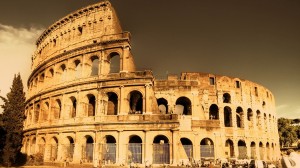 4th place is for Italian Coliseum. Coliseum is one of the most magnificent monuments of the Roman era. It is a symbol of Italy as well as the Eiffel Tower in France or the Kremlin for Russia. The amphitheater was built for 8 years – its construction was begun by Emperor Vespasian in 72 and was completed in 80 by his son Titus. Coliseum walls were erected from large blocks of travertine, fastened together by steel straps with a total weight about 300 tons. Opening of Coliseum was marked by the entertainment events which lasted for 100 days. During this time in gladiatorial tournaments several thousands of soldiers and 5000 wild animals imported from Africa were killed.
4th place is for Italian Coliseum. Coliseum is one of the most magnificent monuments of the Roman era. It is a symbol of Italy as well as the Eiffel Tower in France or the Kremlin for Russia. The amphitheater was built for 8 years – its construction was begun by Emperor Vespasian in 72 and was completed in 80 by his son Titus. Coliseum walls were erected from large blocks of travertine, fastened together by steel straps with a total weight about 300 tons. Opening of Coliseum was marked by the entertainment events which lasted for 100 days. During this time in gladiatorial tournaments several thousands of soldiers and 5000 wild animals imported from Africa were killed.
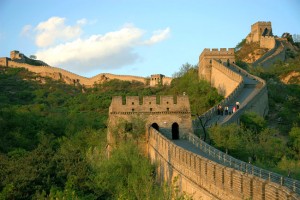 5th place in this list takes Great Wall of China. Great Wall of China is a chain of defensive structures that stretch across the northern China from Liaodong Bay of the Yellow Sea to the sands of the Gobi Desert. The length of the Great Wall in a straight line from one end to another is about 2450 km, and considering all the curves, according to various estimates, it is from 6000 to 8850 km long. Its construction started in 210 BC, with a few interruptions it lasted until the end of the Ming Dynasty, that is until the 1640s. The average height of this wall is about 7.8 meters and its width allowed five infantrymen abreast marching or five riders galloping in the line.
5th place in this list takes Great Wall of China. Great Wall of China is a chain of defensive structures that stretch across the northern China from Liaodong Bay of the Yellow Sea to the sands of the Gobi Desert. The length of the Great Wall in a straight line from one end to another is about 2450 km, and considering all the curves, according to various estimates, it is from 6000 to 8850 km long. Its construction started in 210 BC, with a few interruptions it lasted until the end of the Ming Dynasty, that is until the 1640s. The average height of this wall is about 7.8 meters and its width allowed five infantrymen abreast marching or five riders galloping in the line.
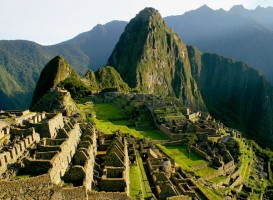 6th place is for Peru Machu Picchu. The ruins of Machu Picchu – “Lost City of the Incas” are hidden in a thicket of jungles, high in the Peruvian Andes and are surrounded from three sides by rugged mountain river Urubamba. The city is built as a sanctuary in 1438 by the ninth ruler of the Inca Empire – Pachacuti Yupanki. More than 300 years this city lived just in legends, and only 100 years ago, a stronghold of the Incas “rose from obscurity” again by the American archaeologist Hiram Bingham. The city flourished; at the height of 3000 meters its inhabitants grew maize, potatoes and other vegetables. Right in the rocks the Incas made terraces, covered them with soil from the Urubamba river valley and erected massive walls that protected the vegetable beds from the sun heat, wind and sand drifts. About 1532 inhabitants of Machu Picchu for unknown reasons left the city, leaving beautiful architectural creations for their descendants.
6th place is for Peru Machu Picchu. The ruins of Machu Picchu – “Lost City of the Incas” are hidden in a thicket of jungles, high in the Peruvian Andes and are surrounded from three sides by rugged mountain river Urubamba. The city is built as a sanctuary in 1438 by the ninth ruler of the Inca Empire – Pachacuti Yupanki. More than 300 years this city lived just in legends, and only 100 years ago, a stronghold of the Incas “rose from obscurity” again by the American archaeologist Hiram Bingham. The city flourished; at the height of 3000 meters its inhabitants grew maize, potatoes and other vegetables. Right in the rocks the Incas made terraces, covered them with soil from the Urubamba river valley and erected massive walls that protected the vegetable beds from the sun heat, wind and sand drifts. About 1532 inhabitants of Machu Picchu for unknown reasons left the city, leaving beautiful architectural creations for their descendants.
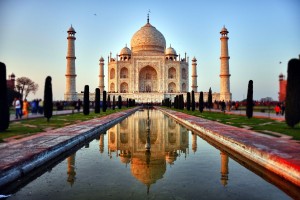 And the last 7th place belongs to Indian Tadzh Mahal. In the history of this white marble masterpiece different facts and legends are deeply intertwined, but most historians agree that the tomb was built in the 1630s by the order of the emperor of the Great Mogul – Shah Jahan in memory of the prematurely deceased wife Mumtaz Mahal. It took about 22 years to continue the construction of this palace. More than 20000 people were involved in its building, including construction workers from all over the empire, as well as the masters from Venice, Persia, Central Asia and the Arab East. Today the white marble monument of great love, “the pearl of Indian architecture” is one of the major attractions of India. The majestic five domical mausoleum with 4 minarets at the corners stands on a 74-meter height on the white marble platform and reflecting in the still artificial ponds, as if hovering over the land like a magical mirage.
And the last 7th place belongs to Indian Tadzh Mahal. In the history of this white marble masterpiece different facts and legends are deeply intertwined, but most historians agree that the tomb was built in the 1630s by the order of the emperor of the Great Mogul – Shah Jahan in memory of the prematurely deceased wife Mumtaz Mahal. It took about 22 years to continue the construction of this palace. More than 20000 people were involved in its building, including construction workers from all over the empire, as well as the masters from Venice, Persia, Central Asia and the Arab East. Today the white marble monument of great love, “the pearl of Indian architecture” is one of the major attractions of India. The majestic five domical mausoleum with 4 minarets at the corners stands on a 74-meter height on the white marble platform and reflecting in the still artificial ponds, as if hovering over the land like a magical mirage.

